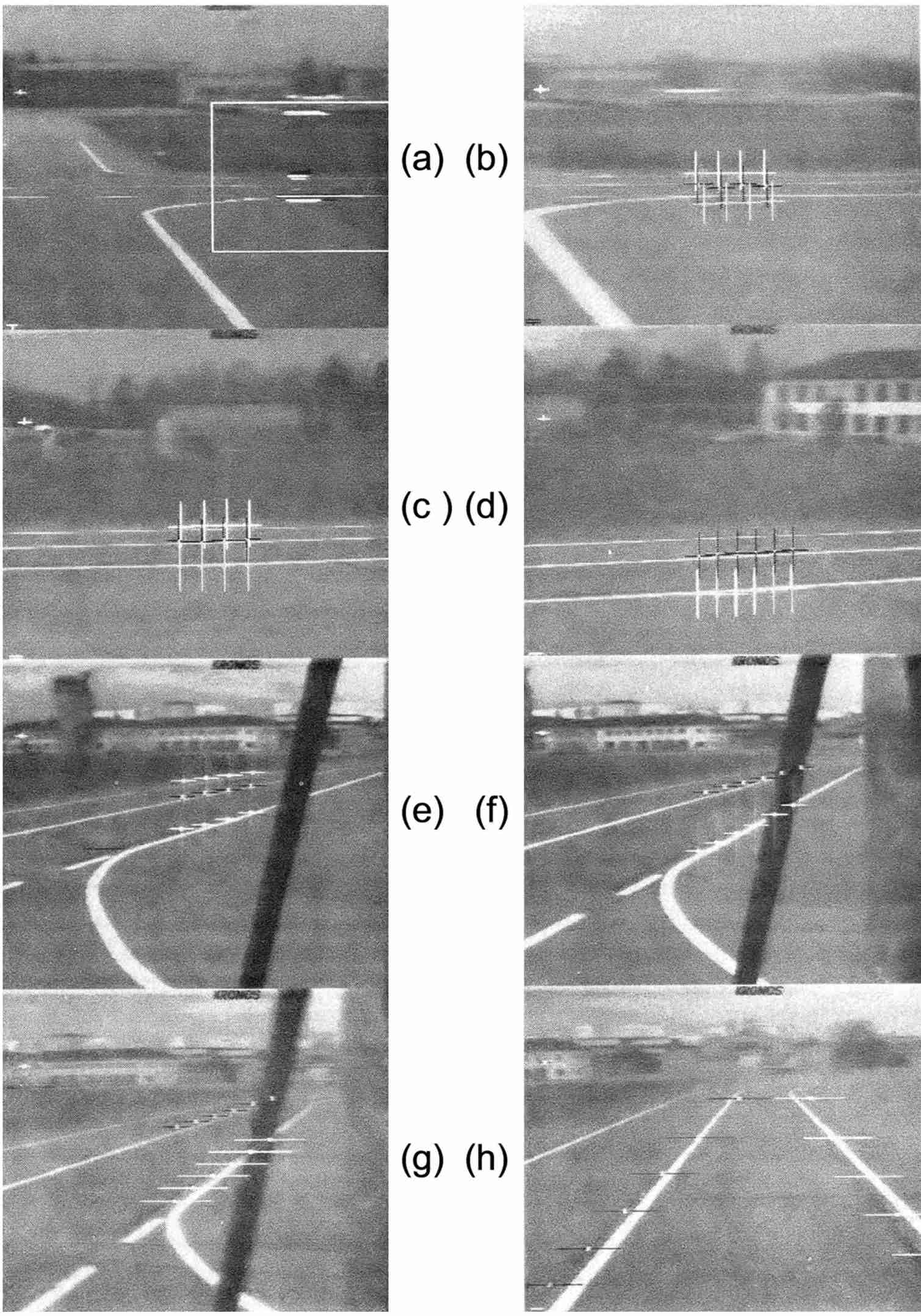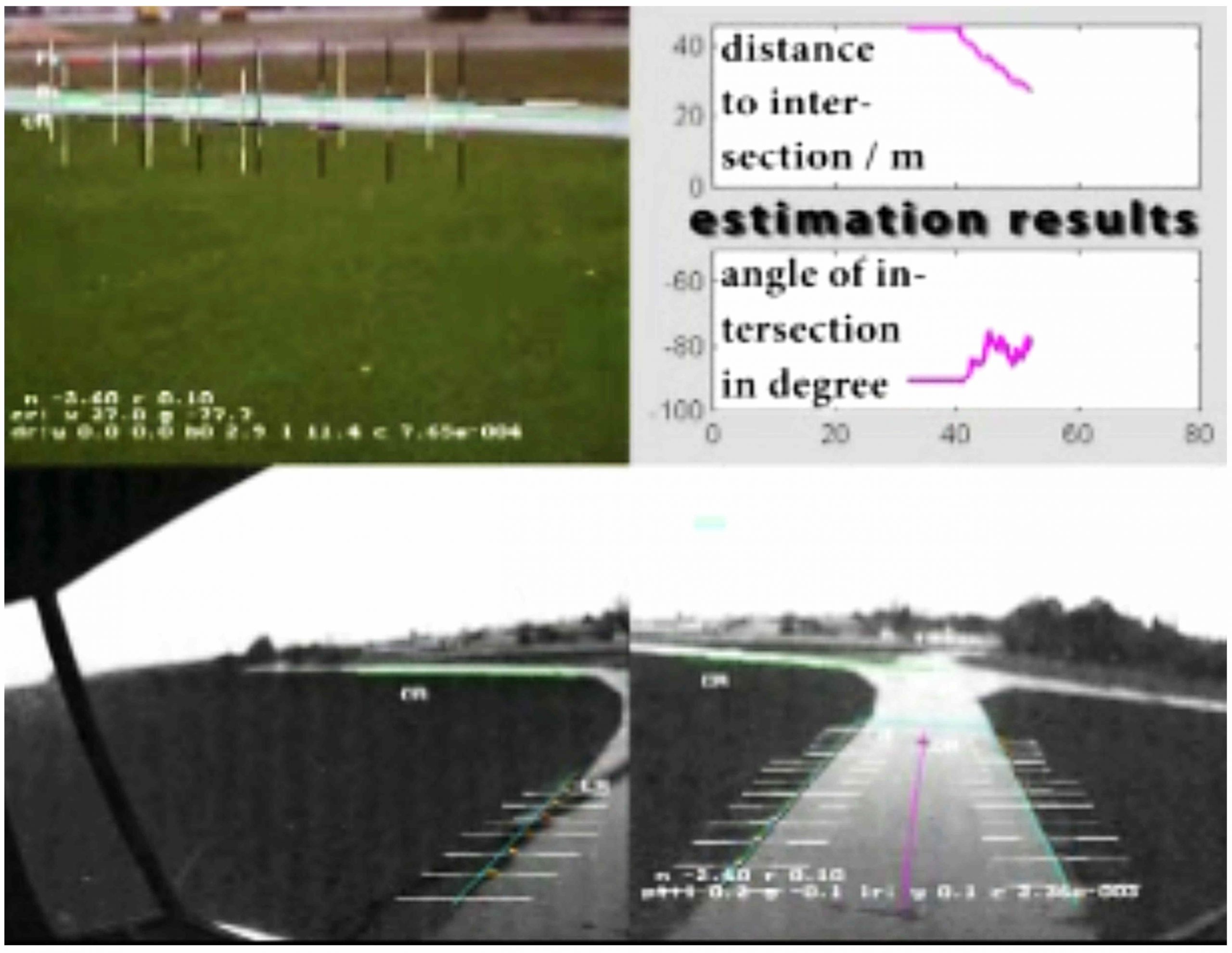A.3.7a Turn right on two-lane roads with lane markings
From GPS- and map information and from the sequence of mission elements to be performed, attention is controlled to detecting a cross-road on the proper side of the road driven; left or right turns require different procedures depending also on the width of the road driven.
The following generic capabilities have been developed in Hardware-In-the-Loop simulation
and later on proven by real-world experiments with VaMoRs on our test track on the former airport Neubiberg as well as on the test site Pfullendorf:
- Detection of a crossroad within a certain range of intersection angles at sufficiently large ranges.
- Determine range to the intersection point, width of the crossroad and the intersection angle by active vision while approaching.
- Selection of the proper feed-forward turn-off steering program over time and of the optimal trigger point for initiation.
- Superposition of lateral feedback control derived from crossroad tracking in the final part of the stereotypical maneuver to counteract perturbations and errors accumulated.
Video – TurnoffNbbTaxiway 1996
A.3.7b Turn left on a dirt road without lane markings exploiting trinocular
The video shows a test run on the taxiways of the former airport Neubiberg, in which the geometry of the path to be driven was not known to the perception system. It only had the information that there would appear a crossroad (exact position and intersection angle unknown), onto which a turn to the left had to be made. The estimation process for these parameters is shown in the video.
References
Baten S, Müller N. (1995). Navigation with an Autonomous Vehicle on Arbitrary Roads. In Linkwitz et al. (eds): High Precision Navigation. Dümmler Verlag, Bonn, pp. 415-42
Dickmanns ED, Müller N (1995). Scene Recognition and Navigation Capabilities for Lane Changes and Turns in Vision-Based Vehicle Guidance. Control Engineering Practice, 2nd IFAC Conf. on Intelligent Autonomous Vehicles-95, Helsinki pdf
Müller N, Baten S (1995). Image Processing based Navigation with an Autonomous Car. Int. Conf. on Intelligent Autonomous Systems, IAS-4, Karlsruhe, pp 591-598
Müller N (1996). Autonomes Manövrieren und Navigieren mit einem sehenden Straßenfahrzeug, Diss., UniBwM / LRT. Kurzfassg
Lützeler M, Dickmanns ED (2000). EMS-Vision: Recognition of Intersections on Unmarked Road Networks. Proc. Int. Symp. on Intelligent Vehicles (IV’2000), Dearborn, (MI) pdf
Gregor R, Lützeler M, Pellkofer M, Siedersberger KH, Dickmanns ED (2001). A Vision System for Autonomous Ground Vehicles with a Wide Range of Maneuvering Capabilities. Proc. ICVS, Vancouver
Gregor R (2002). Fähigkeiten zur Missionsdurchführung und Landmarkennavigation. Dissertation, UniBwM / LRT. Kurzfassg
Pellkofer M, Hofmann U, Dickmanns ED (2003). Autonomous cross-country driving using active vision. SPIE Conf. 5267, Intelligent Robots and Computer Vision XXI: Algorithms, Techniques, and Active Vision. Photonics East, Providence, Rhode Island
Pellkofer M (2003). Verhaltensentscheidung für autonome Fahrzeuge mit Blickrichtungssteuerung. Diss., UniBwM, LRT. Kurzfassg
Siedersberger K-H (2004). Komponenten zur automatischen Fahrzeugführung in sehenden (semi-) autonomen Fahrzeugen. Dissertation, UniBwM, LRT, Kurzfassg
Dickmanns ED (2007). Dynamic Vision for Perception and Control of Motion. Springer-Verlag, (Chapter 10) Content

